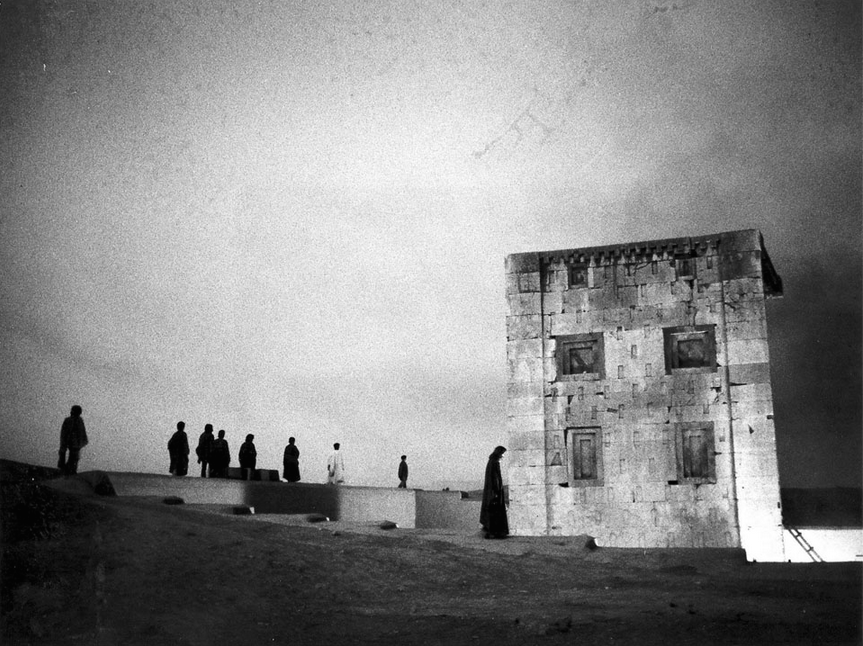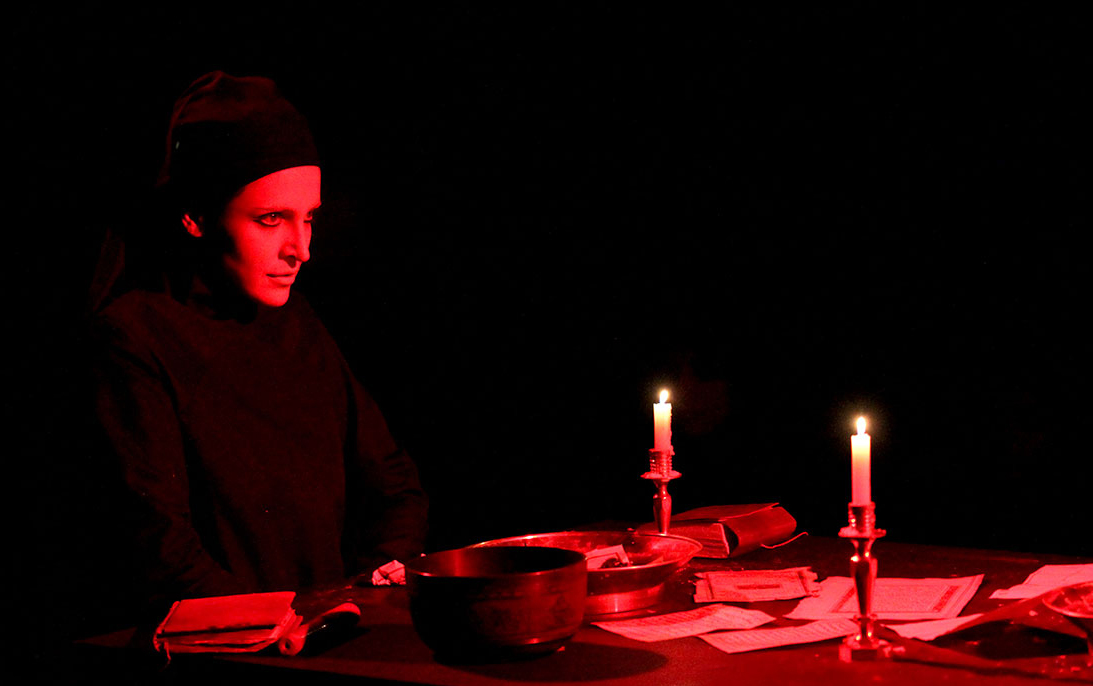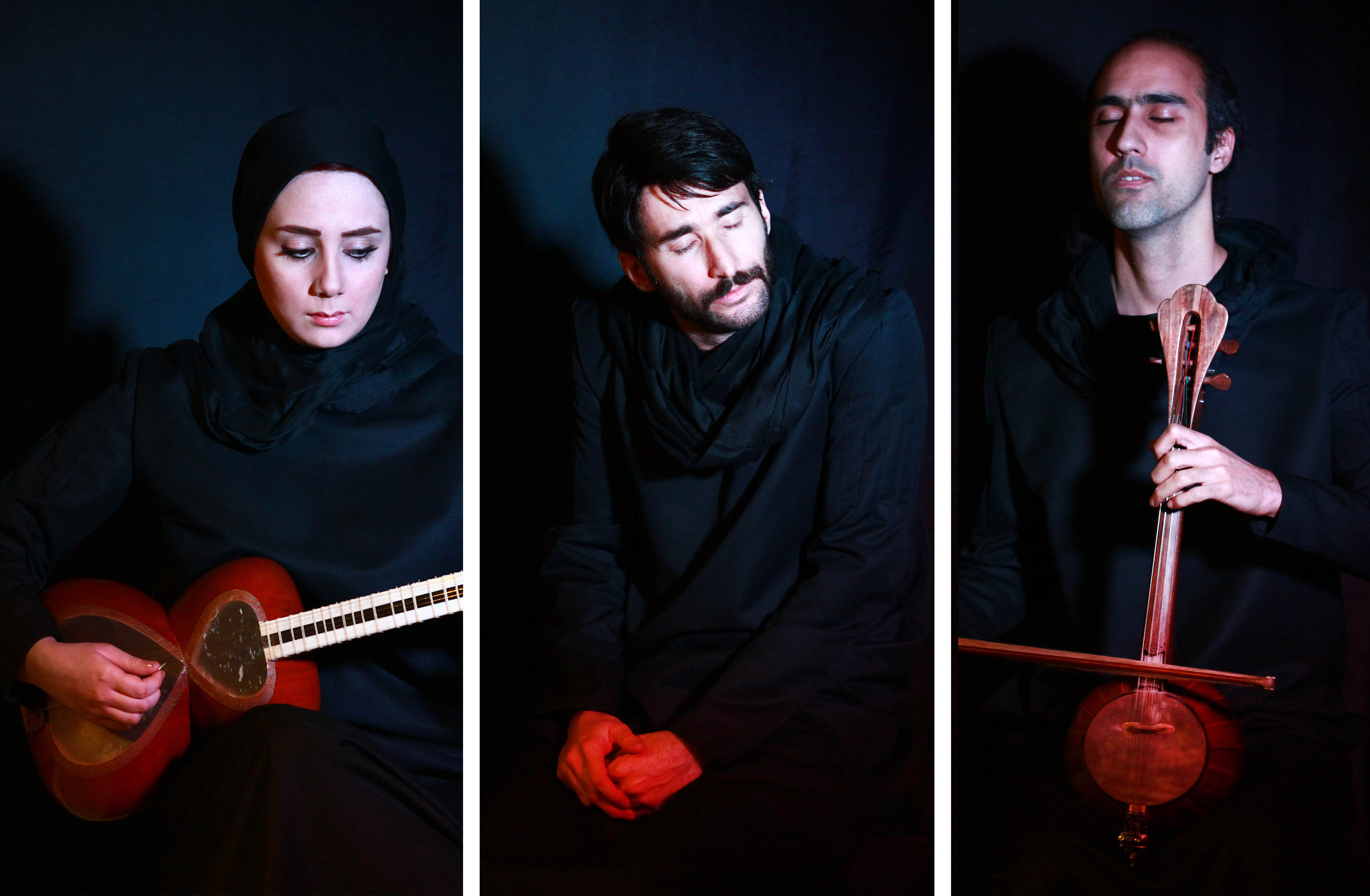Ali Ettehad on performance art in Iran and his struggle to bring it to the public
Translated from Persian by Joobin Bekhrad
When it comes to contemporary art in Iran, one often hears about the country’s bustling gallery scene, its innumerable painters, photographers, and sculptors, and the prices set by local artists in auctions both at home and abroad. What one rarely hears about, however, is performance art, a medium with a relatively shorter history in Iran, and one that has been given far less attention by artists and audiences alike. While it is difficult to talk in terms of a proper ‘scene’ in the country, there are, nonetheless, artists who are devoting themselves to their performances, and fighting against the odds to perform and introduce everyday audiences on the city’s streets to the medium. Nobody said it would be easy; but then again, nobody said it would be impossible, either.
Based in Tehran, Ali Ettehad is an artist and curator. Along with his wife, Nikoo Tarkhani (an artist as well), he has been at the forefront of performance art in Iran, and is also one of the better-known names in the country’s contemporary art scene in general. Together, this artist power-couple performs in Tehran, curates exhibitions and performance art series, hosts seminars, and produces films, among other things. I recently spoke with Ali – one half of his and Nikoo’s Anahita Art Studio – to find out about what he’s been up to since I caught up with him last in Tehran in 2013, as well as the current state of performance art there. Although he does like to keep secrets, Ali was generous enough to share a few of his with me.
Unlike other forms of art in Iran – e.g. visual art, cinema, music, etc. – performance art has a relatively shorter history. What were the origins of performance art in Iran, and why do you think it has received little attention in comparison to other art forms?
You of course have to remember that performance art, vis-à-vis other artistic mediums, is new all around the world in general; that’s why it’s taken much longer for it to be recognised in Iran, and for Iranian performance art to receive outside attention. The short history and newness of performance art aside, however, I do agree with you. As a medium, it has often been neglected, and has not received due attention. Performance art was seen for the first time in Iran in the 70s, and took shape on the fringes of the Shiraz-Persepolis Festival of Arts (earlier performances may have existed, but there are no known historical records of them), although following the Revolution in 1979, it became largely forgotten. Activity picked up again after 2000, however, and in the early years of the 21st century, much interest was shown in contemporary artistic mediums. Beginning in 2005, there was a surge of investment in the domestic art market (particularly from abroad), and Iranian art began to perform particularly well in Middle Eastern art auctions.

A performance of Peter Brook and Ted Hughes’ Orghast by the ‘Kaaba’ of Zoroaster during the 1971 Shiraz-Persepolis Festival of Arts
It was because of developments like these that non-commercial and non-sellable mediums such as performance art were once again pushed to the fringe. Taking into consideration the fact that the local art scene is dominated by private galleries (as opposed to state-run institutions or galleries receiving support from local municipalities) that are commercially-oriented, mediums such as performance art have never had the chance to be the centre of attention; and, even if performances are structured so that artists do not incur any costs (which is rarely the case), they still have to undergo a tortuous process in order to find suitable venues, especially in a country like Iran where it is forbidden to perform in most public spaces.
I generally believe that in the past decade, the Iranian art scene has revolved around the buying and selling of art, and the desire to make profits from it. The funny thing about all of this is that the history of performance art has remained stagnant. What I mean to say is that in Western Europe and North America, performance art was a major medium artists employed to ‘escape’ the commercial aspects of art; this has never happened in Iran – not only in the case of performance art, but in that of all other non-sellable mediums as well.
How would you describe the performance art ‘scene’ in Iran? What sorts of things are happening in Tehran and elsewhere, and who should we be keeping an eye on? Where are the best places to witness performance art?
Honestly, there is such little performance art in Iran that we can’t really talk in terms of a ‘scene’. Nonetheless, there have been positive developments that have helped to bring about something of a scene there. For example, Amir Rad, a gallery director, has been very active. Continuously, for the past four years, he has been overseeing the 30 Performances, 30 Artists, 30 Days (Si Performans, Si Honarmand, Si Rooz) festival, wherein each day a different artist is given the opportunity to perform in the East Gallery, working within the theme chosen for a particular year. The majority of the participants of the festival, however – particularly in the first three years –were theatre actors, and their performances were more theatrical than performance-based. In many cases, however, the lines were blurred between different performance mediums, and sometimes became so hidden that it’s really difficult to label everything under the name of one specific medium. Despite the fact that most of the participants have been theatre actors, though, the focus has always been on performance art.
In 2014, you began the 1,001 Evenings performance series – how was that received? Is it still running? Where did the idea for that come from?
Four years ago, I established an art studio by the name of Anahita, whose aim was – and still is – to hold art-related events. My colleagues and I sometimes discuss events that sometimes end up becoming our focus at particular moments in time. When I wrote the synopsis of 1,001 Evenings (Hezar-o Yek Asr), I was thinking very specifically about what spaces we had recourse to, how to attract audiences, and in general, taking art to public spaces. Exactly a year prior to that, I was working as the Director of the Qasr Museum Garden (Bagh-e Moozeh-ye Qasr), and a café was being built on the grounds of the museum that its directors wanted to turn into a sort of gallery space. On behalf of Anahita Art Studio, I submitted a proposal to have the space dedicated to performance art; the proposal was accepted, and we straightaway began focusing on the project. We held 10 events there, but soon the security forces came and put an end to our activities. They told us that the international media had begun covering our activities, whereas they preferred us to attract as little attention as possible and quickly end what we were doing. Because we were working with a tight budget, and Anahita Art Studio was incurring all the costs, they assumed that we’d give up quickly. Afterwards, private art spaces invited us to do performances, but I insisted that we perform in public spaces, and as a result, the project was put on hold for a while. Its continuation is still in our agenda, although we’re not ready to begin working on it again at the moment.
The title, 1,001 Evenings, as is obvious, comes from the Thousand and One Nights (Hezar-o Yek Shab). In the tale, Shahrzad (Scheherazade) is summoned to Prince Shahryar’s chambers, and the day after, handed over to her executioner. In order to delay her death, she devises a plan to tell Shahryar a tale every night; the stories are so long that they continue well into the morning, and leave Shahryar wanting to know what happens next. She does this for three years, and in due course gives birth to three children, until finally Shahryar gives up his plans to do away with her.
I strongly believe that at a time – especially in the Middle East – when markets are dictating what artists should produce, and art is, for the most part, commercially-driven, performance art is powerful in its ability to help artists retain their independence and integrity, until such a time (in the near future, I feel) when this huge ‘bubble’ (i.e. this surge of commercial interest in Iranian art) will burst. This is coming from the perspective of an artist and artistic director who believes that an active art market is at the same time necessary and vital. However, considering the Middle Eastern art market, and especially that of Iran, I think there’s an inordinate amount of attention being given to the commercial aspects of art.
What current performance projects are you involved in at the moment? Tell me a bit about Requiem for Libricide. I’ve only seen the images you’ve been posting on social media, but they look incredibly interesting.
At the present, I’m working on a performance similar to the ones I presented last year. Requiem for Libricide (Marsieh-i Barayeh Ketabsoozi-ha) is the 23rd installment of the Razvarzi (Keeping Secrets) series. Razvarzi is, in reality, the title of a body of work I’ve been involved with for a long time; I say ‘long time’ and not ‘always’, because last year I worked on some projects that were outside the scope of Razvarzi. The term razvarzi is one that holds much importance in Oriental studies. Imagine a group of people that have particular beliefs and characteristics, and are joined by an outsider who has been given permission to join their circle under the condition that he takes an oath to guard their secrets; something similar to the concept of brotherhoods that carried over into the West from the East. This notion of communication and understanding has always been very interesting to me, and has served as the basis for almost all of my work.

Nikoo Tarkhani in A Requiem for Libricide
Over the years, I’ve come up with ‘secrets’ of my own, and in each performance, clues are given to the audience to unravel them; I find this both interesting and playful at the same time. On the surface, the performances are quite serious, but from my perspective, they’re really cheeky! All of this aside, each and every one of my performances has a mystical quality to it, and touches on sociopolitical issues. Without exception, I draw on historical patterns that continue to influence us socially and politically. For instance, how has the constant lack of fresh water in Iran impacted our mindset? Or, which ancient figures and tales are still alive, and how do they influence the psychology of us Iranians?
I strongly believe that at a time – especially in the Middle East – when … art is, for the most part, commercially-driven, performance art is powerful in its ability to help artists retain their independence and integrity
As the name suggests, Requiem for Libricide uses the ‘excuse’ of book burning to explore important issues such as omissions, censorship, and amnesia. It is an interactive performance that utilities various media. In the darkness, audiences enter a space three stories high. Opposite them stands a performer in long robes looking like an ancient elder, holding a bright candlestick in his hand. He speaks to the audience, and later takes them to the basement of the venue. There, viewers witness an installation that provides the overview to the performance. Afterwards, he leads them to the second floor, where four individuals around a table conduct a live performance, and in the end, the show ends with live music.

Naghmeh Moradabadi, Hamed Kazemi, and Joobin Kalhor in A Requiem for Libricide
The idea behind the performance is to take audiences on a tour through history: a tour throughout the lands of the Middle East and the former Byzantine Empire to experience their ancient cultures.
You once mentioned the fact that the same audiences appeared at galleries for performances frustrated you, and that this prompted you to take your art to the streets. Have things changed at all? I’ve also found that to be the case in Tehran, more or less, with visual art.
I still feel the same. The audience of private galleries in Tehran is extremely limited; after attending major openings in Tehran for two months, you can be sure to have seen all the influential players in the local art scene there. The important thing to note is that most of them are either professional artists, amateurs, art students, art enthusiasts, or amateur collectors (we have very few professional collectors in Tehran, and at best, have to deal with businesspeople who collect art on the side – in many cases for tax incentives – and middlemen who know very little about art and are only after profits). You rarely see ordinary people who spend their days off to visit private galleries. Because of this, and the fact that advertising and promotion haven’t done much for us in this case, I thought to myself, why don’t my friends and I take our art to the streets?
1,001 Evenings was well-received; many audiences – even passersby outside the museum – attended our performances. All the performances were free to witness, and naturally, many ordinary people came to see them. Even whilst selling tickets for my latest work (A Requiem for Libricide), the result has been the same. Though we have a 100-person capacity for each play, during our past 35, over 4,000 people have attended! Certainly, had we done the performances in a private space (e.g. a gallery), we wouldn’t have been able to attract and deal with such numbers, and, more importantly, such diverse audiences.
What do you envision for the near future of performance art in Iran? Do you think more artists will begin working in this medium, or will it continue to exist on the fringe? What is necessary, in your opinion, for a ‘healthy’ performance art scene?
It seems like, especially in the past five years, more and more young artists have begun using performance as an artistic medium. Performance art usually doesn’t require large budgets, and this has been a factor in many artists’ decisions to experiment with performance art. I think performance art in Iran is writing its regional history as we speak. While in the beginning many were merely experimenting with the medium, as time has passed, artists have begun to work with it seriously and for the right reasons, apart from their commercial endeavours.
One of the most important elements in establishing a ‘healthy’ performance art scene is the ability to distinguish between art that is meant to be seen, and art that is meant to be performed – and by the same token, from theatre. From the outset, artists need to be familiar with the history of performance art, as well as aesthetic notions. I don’t believe whatsoever that mediums shouldn’t be mixed; I myself do it in my own work. However, I really think that when it comes to doing so, one should have a good understanding of each individual medium. More than ever, I think artists today are in need of solid technical knowledge. Before, if you were to visit the studio of a master (during the Modernist period, for instance), you would mostly see their tools and utensils; now, you see walls lined with bookshelves. This is incredibly important to me. In any case, from what I’ve witnessed in the past decade, I envision a bright future for performance art in Iran, and can see people slowly becoming more familiar with it, talking about it, and anticipating future performances.
Because little literature on the subject exists in Persian, many audiences do not have correct notions regarding it. For instance, in many cases I’ve seen that some audiences have expressed the belief that performance art, by nature, requires interactivity. When it comes to other branches of live art, there have been even more misunderstandings, and audiences in general don’t know anything about what they’re seeing. Such little has been written in Persian about performance art that after almost 15 years of its contiguous presence in Iran, only five specialist books have been published on the topic, and only one magazine and journal have printed one article each about it. Despite all these setbacks, however, I think the performance art scene in Iran will grow and become more active in the coming years.

